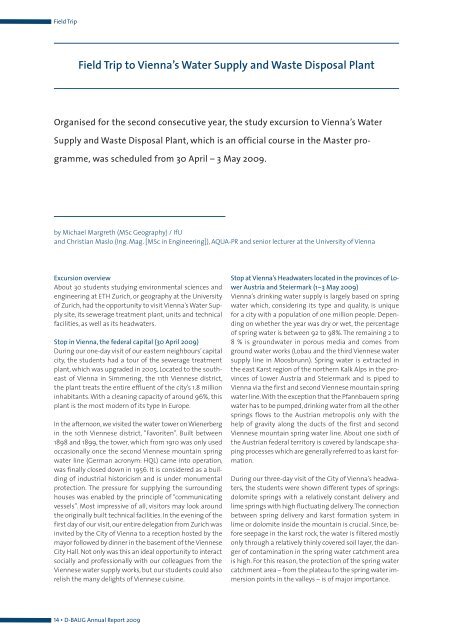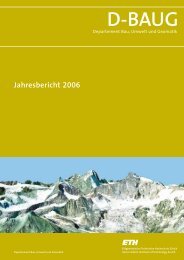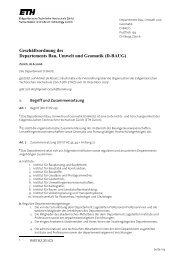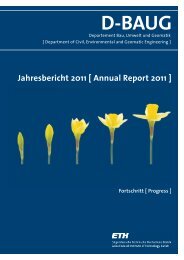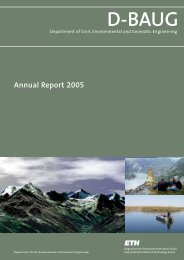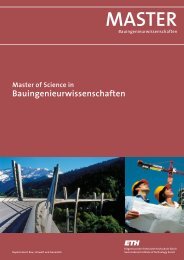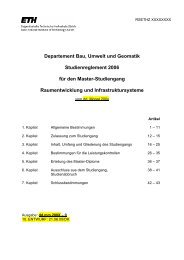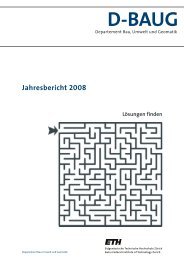D-BAUG - Departement Bau, Umwelt und Geomatik - ETH Zürich
D-BAUG - Departement Bau, Umwelt und Geomatik - ETH Zürich
D-BAUG - Departement Bau, Umwelt und Geomatik - ETH Zürich
Create successful ePaper yourself
Turn your PDF publications into a flip-book with our unique Google optimized e-Paper software.
Field Trip<br />
Field Trip to Vienna’s Water Supply and Waste Disposal Plant<br />
Organised for the second consecutive year, the study excursion to Vienna’s Water<br />
Supply and Waste Disposal Plant, which is an official course in the Master pro-<br />
gramme, was scheduled from 30 April – 3 May 2009.<br />
by Michael Margreth (MSc Geography) / IfU<br />
and Christian Maslo (Ing. Mag. [MSc in Engineering]), AQUA-PR and senior lecturer at the University of Vienna<br />
Excursion overview<br />
About 30 students studying environmental sciences and<br />
engineering at <strong>ETH</strong> Zurich, or geography at the University<br />
of Zurich, had the opportunity to visit Vienna’s Water Supply<br />
site, its sewerage treatment plant, units and technical<br />
facilities, as well as its headwaters.<br />
Stop in Vienna, the federal capital (30 April 2009)<br />
During our one-day visit of our eastern neighbours’capital<br />
city, the students had a tour of the sewerage treatment<br />
plant, which was upgraded in 2005. Located to the southeast<br />
of Vienna in Simmering, the 11th Viennese district,<br />
the plant treats the entire effluent of the city’s 1.8 million<br />
inhabitants. With a cleaning capacity of aro<strong>und</strong> 96%, this<br />
plant is the most modern of its type In Europe.<br />
In the afternoon, we visited the water tower on Wienerberg<br />
in the 10th Viennese district, “Favoriten”. Built between<br />
1898 and 1899, the tower, which from 1910 was only used<br />
occasionally once the second Viennese mountain spring<br />
water line (German acronym: HQL) came into operation,<br />
was finally closed down in 1956. It is considered as a building<br />
of industrial historicism and is <strong>und</strong>er monumental<br />
protection. The pressure for supplying the surro<strong>und</strong>ing<br />
houses was enabled by the principle of “communicating<br />
vessels”. Most impressive of all, visitors may look aro<strong>und</strong><br />
the originally built technical facilities. In the evening of the<br />
first day of our visit, our entire delegation from Zurich was<br />
invited by the City of Vienna to a reception hosted by the<br />
mayor followed by dinner in the basement of the Viennese<br />
City Hall. Not only was this an ideal opportunity to interact<br />
socially and professionally with our colleagues from the<br />
Viennese water supply works, but our students could also<br />
relish the many delights of Viennese cuisine.<br />
14 ▪ D-<strong>BAUG</strong> Annual Report 2009<br />
Stop at Vienna’s Headwaters located in the provinces of Lower<br />
Austria and Steiermark (1–3 May 2009)<br />
Vienna’s drinking water supply is largely based on spring<br />
water which, considering its type and quality, is unique<br />
for a city with a population of one million people. Depending<br />
on whether the year was dry or wet, the percentage<br />
of spring water is between 92 to 98%. The remaining 2 to<br />
8 % is gro<strong>und</strong>water in porous media and comes from<br />
gro<strong>und</strong> water works (Lobau and the third Viennese water<br />
supply line in Moosbrunn). Spring water is extracted in<br />
the east Karst region of the northern Kalk Alps in the provinces<br />
of Lower Austria and Steiermark and is piped to<br />
Vienna via the first and second Viennese mountain spring<br />
water line.With the exception that the Pfannbauern spring<br />
water has to be pumped, drinking water from all the other<br />
springs flows to the Austrian metropolis only with the<br />
help of gravity along the ducts of the first and second<br />
Viennese mountain spring water line. About one sixth of<br />
the Austrian federal territory is covered by landscape shaping<br />
processes which are generally referred to as karst formation.<br />
During our three-day visit of the City of Vienna’s headwaters,<br />
the students were shown different types of springs:<br />
dolomite springs with a relatively constant delivery and<br />
lime springs with high fluctuating delivery.The connection<br />
between spring delivery and karst formation system in<br />
lime or dolomite inside the mountain is crucial. Since, before<br />
seepage in the karst rock, the water is filtered mostly<br />
only through a relatively thinly covered soil layer, the danger<br />
of contamination in the spring water catchment area<br />
is high. For this reason, the protection of the spring water<br />
catchment area – from the plateau to the spring water immersion<br />
points in the valleys – is of major importance.


